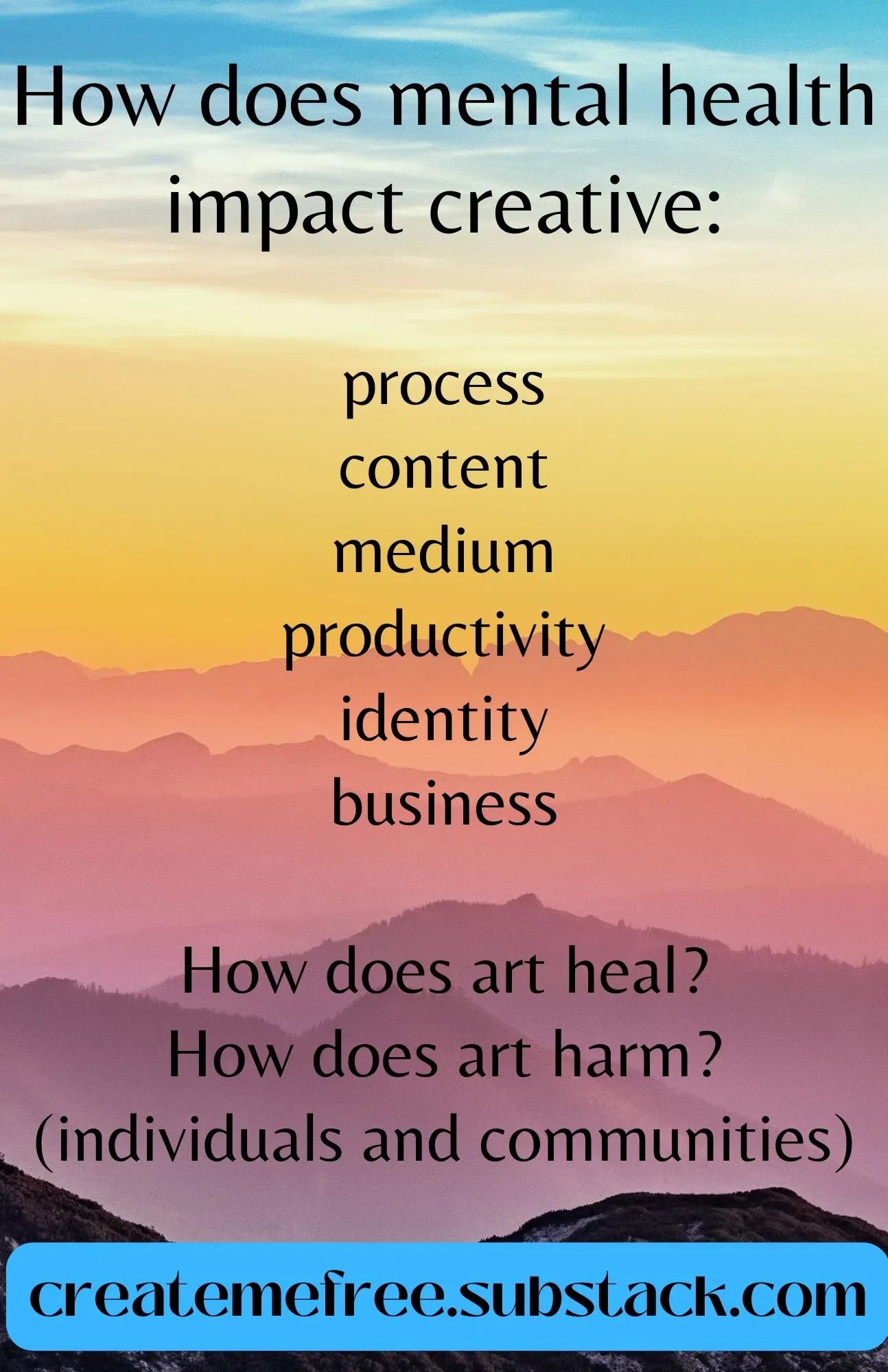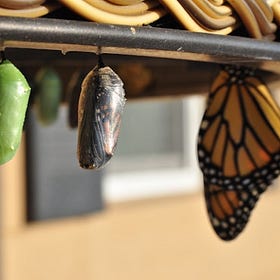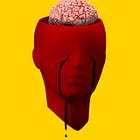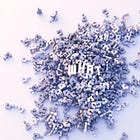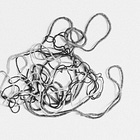What Does It Mean to Consider The Ways in Which Health Impacts Art?
An overview of the framework that I use to explore this topic along with examples
My focus is on exploring the complex relationship between art and health. But what exactly does that mean? There are many different mental and physical health conditions (as well as more vaguely-defined life challenges such as “burnout”) that impact our creativity. This isn’t good or bad, per se. But knowing what the impact is on us individually is a powerful first step towards working with ourselves instead of against ourselves.
I have created a framework through which I consider all aspects of this topic, looking at how health symptoms impact artistic process, productivity, medium, content, self-perception and reception by others. I also research how art heals individuals and communities, how art may harm, and how experiencing art (rather than creating it) can also be impactful.
Here, I’ll breakdown some of what I consider when researching each category. Plus I’ll share related links for further exploration of how others have expressed their experiences of these things.
I work with artists/writers/creatives to help them understand the relationship of health to creativity in their own lives in order to achieve holistic wellness and success.
Mental Health and Creative Process
The creative process is the series of steps and stages that individuals go through to generate, develop, and express their creative ideas and bring them to fruition. Everyone’s process is different but it includes things like preparation and inspiration, routines and rituals, the physicality of doing the work, and the ultimate review and sharing of the work.
Examples include:
Creative blocks
Inconsistency in work habits
Challenges with focus and concentration
Lack of motivation
Perfectionism and self-criticism
Impacts on the creative flow
Changes in creative routines and rituals
Difficulty in starting or finishing projects
Coping with anxiety and stress during the creative process
Coping with the frustration and self-doubt that can arise from creative blocks.
The impact of medication side effects on cognitive abilities and creativity.
Balancing the need for solitude and concentration with the benefits of social interaction for mental health.
Navigating the challenges of mood swings and how they can disrupt the creative flow.
Managing the fear of sharing vulnerable work when experiencing mental health symptoms.
The potential for self-isolation during depressive episodes, affecting collaboration and inspiration.
Finding strategies to stay organized and on track when dealing with symptoms like ADHD.
Addressing the pressure to produce and perform despite mental health struggles.
How do mental health symptoms impact/alter/inspire creative process?
13 creatives respond in their own unique ways about how the mind impacts the creative process ...
Mental Health and Creative Content
Ways in which mental health/wellness/challenges may impact creative content, meaning the themes explored in the work can include the way challenges alter the depth of the work, the symbolism used, and the narrative, as well as times when art is used as advocacy or activism in relation to mental health. Examples:
Themes of mental health and wellness in the work
Changes in the depth and emotional resonance of the content
Use of symbolism related to mental health challenges
Narratives that reflect personal mental health experiences
Art used as a form of advocacy or activism for mental health awareness
Struggles with avoiding or confronting triggering content when exploring mental health themes.
The challenge of accurately depicting mental health experiences without romanticizing or stigmatizing them.
Balancing authenticity and privacy when incorporating personal experiences into creative content.
Dealing with resistance from others who may misinterpret or misunderstand the intentions behind mental health-themed work.
The ethical considerations of using potentially distressing content for artistic purposes.
Coping with creative burnout when trying to convey intense mental health themes.
The potential for self-censorship when mental health experiences are deemed "too dark" for public consumption.
Overcoming the fear of being pigeonholed as an artist solely focused on mental health content.
Mental Health and Creative Medium
Sometimes during a mental health challenge, people turn to very familiar mediums for comfort and sometimes they instead try something new for distraction, as just one example. In some instances, issues of changing the scale of work show up in this section, although sometimes that’s also part of the creative process. Examples include:
Adaptation to various health conditions when choosing a medium
Exploration of new mediums as a form of distraction or coping
Challenges related to changing the scale or scope of creative work
Use of familiar mediums for comfort and expression
How mental health influences the choice of subject matter and style
Adapting to the limitations of physical and mental health conditions when selecting creative mediums.
The challenges of transitioning between different mediums while maintaining a consistent artistic identity.
Addressing the potential financial burden of acquiring materials for specific creative mediums.
The influence of medication on fine motor skills and artistic precision.
Dealing with societal expectations and stereotypes regarding artists and their chosen mediums.
Balancing the desire for experimentation with the limitations imposed by mental health symptoms.
Overcoming resistance to exploring new mediums during periods of anxiety or depression.
The need for accessibility accommodations for artists with physical and mental health challenges in various creative spaces.
Mental Health and Creative Productivity
Mental health/wellness/challenges may impact creative productivity which often comes up for people who find that depression/anxiety/burnout/etc can impact motivation/ability to work, the role of procrastination, perfectionism, etc. Examples:
Impact of depression, anxiety, or burnout on creative productivity
Motivational challenges and difficulty getting started
Procrastination and avoidance behaviors
Struggles with maintaining a consistent creative schedule
Perfectionism leading to slow progress or unfinished projects
Strategies for coping with procrastination and avoidance behaviors linked to depression and anxiety.
The impact of medication-induced fatigue on creative productivity.
Addressing the fear of failure that can hinder progress and motivation.
Finding ways to maintain a consistent creative routine during episodes of mental distress.
Strategies for managing perfectionism without allowing it to stall creative projects.
Navigating the fine line between pushing oneself to create and respecting the need for rest during symptoms.
Balancing the desire for productivity with the importance of self-care during mental health crises.
The potential for creative productivity to serve as both a coping mechanism and a source of added stress.
Mental Health and Creative Identity/Self-Perception
Mental health/wellness/challenges may impact an artist’s creative identity and self-perception including issues of self-doubt and self-esteem, fear of failure or success, what it means to identify as an artist/writer/creative, etc. How does creating your art and sharing it with the world impact how you see yourself? Some examples:
Self-doubt and low self-esteem as they relate to creative identity
Fear of failure or success in creative endeavors
How the act of creating art influences one's self-perception
The role of self-identity as an artist/writer/creative
Coping with self-criticism and self-compassion in the creative process
Overcoming imposter syndrome and feelings of inadequacy related to mental health symptoms.
The challenge of reconciling personal identity with the public persona of an artist.
Strategies for combating self-doubt and cultivating self-esteem within the context of mental health challenges.
Dealing with the fear of rejection and criticism in light of personal struggles.
Finding ways to redefine and reclaim one's identity as an artist during periods of instability.
Coping with the external pressure to conform to societal expectations of artistic success despite mental health struggles.
The role of self-identity in shaping an artist's creative choices and subject matter.
Balancing self-compassion with the pursuit of artistic excellence within the context of mental health challenges.
Mental Health and Creative Business
Mental health/wellness/challenges may impact creativity as a business and how money complicates things related to holistic wellness for artists. Issues of reception by others, work-life balance, self-promotion, charging for work, etc. How does the realistic need for money tie into the way work is created, how does that impact mental health and how do mental health symptoms impact that business process? For example:
Reception and feedback from others impacting mental health
Balancing work-life demands and creative pursuits
The role of self-promotion and marketing in mental wellness
Charging for creative work and financial considerations
Navigating the need for income with creative passion
Managing the impact of mental health symptoms on the business side of art
The potential impact of mood swings and symptoms on artists' responses to client interactions and deadlines.
Strategies for maintaining professionalism and client relationships during mental health crises.
The challenge of pricing and valuing one's work while navigating mental health-related self-esteem issues.
Managing the stress and anxiety associated with self-promotion and marketing efforts.
Addressing the potential for isolation and burnout when juggling the demands of creative business and mental health.
The financial implications of investing in self-care and mental health support.
Overcoming societal stigma around mental health issues in the context of a creative business.
Finding strategies for maintaining a healthy work-life balance while managing mental health challenges within the creative industry.
How Art Heals
Naturally we often talk about how is therapeutic /cathartic. While this isn’t my emphasis (because there’s already so much written about this), sometimes there’s such great stuff to share in this area. It’s not to be overlooked. Areas of exploration might include:
Therapeutic and cathartic aspects of creating art
Art as a form of self-expression and emotional release
Coping with trauma and grief through art
Art as a tool for self-discovery and healing
Art therapy and its impact on mental health
Exploring the role of art as a form of self-soothing and emotional regulation during mental health crises.
Strategies for harnessing the therapeutic benefits of art while avoiding overreliance on it as the sole coping mechanism.
Addressing the potential for vulnerability when sharing personal art as a means of healing.
Navigating the fine line between art as a therapeutic tool and art as a form of escapism.
Strategies for seeking professional art therapy when self-help methods are insufficient.
Understanding the limitations of art as a healing tool and knowing when to seek additional mental health support.
The potential for artistic expression to serve as a form of advocacy for mental health awareness and destigmatization.
How Art Harms or is Complicated
We often don’t like to talk about how art can harm/hinder us as individuals and in community, but it can for all types of reasons from the actual impact of the art making itself on our physical and mental wellness to the systemic challenges faced in the business of art. Talking about this helps us all figure out ways to mitigate the harm and celebrate the therapeutic power of art.
Physical and mental health impacts of certain art-making processes
Challenges and harm caused by art-related stress and pressure
Systemic issues in the art world affecting artists' mental well-being
Coping with criticism, rejection, and negative feedback
Exploration of the darker aspects of art and its potential harm
Art in Community
What is the role of art museums, galleries, schools, and public art spaces in terms of concern for the mental health of artists, visitors, and staff? What does it mean for artists to live in a capitalist society and how can community shift to support creative, holistic wellbeing? Things to consider:
The role of art spaces in supporting mental health of artists
Community efforts to foster holistic well-being in the arts
Mental health awareness initiatives in art organizations
The impact of capitalism on artists' mental health and well-being
Art as a form of community connection and support
The Power of Experiencing Art
Mostly I share thoughts from people about making art as it relates to mental health but I have discovered over time that there’s a lot of power in experiencing art (viewing, reading, etc.), so let’s talk about that too!
The therapeutic benefits of viewing, reading, or consuming art
Art as a source of inspiration and emotional resonance
Coping with personal challenges through consuming art
Art's role in fostering empathy and understanding
Exploring the transformative power of engaging with art
If you read this far, perhaps you liked the work. The work does take work. It only continues with support, so please consider subscribing.
Another way of looking at this:


